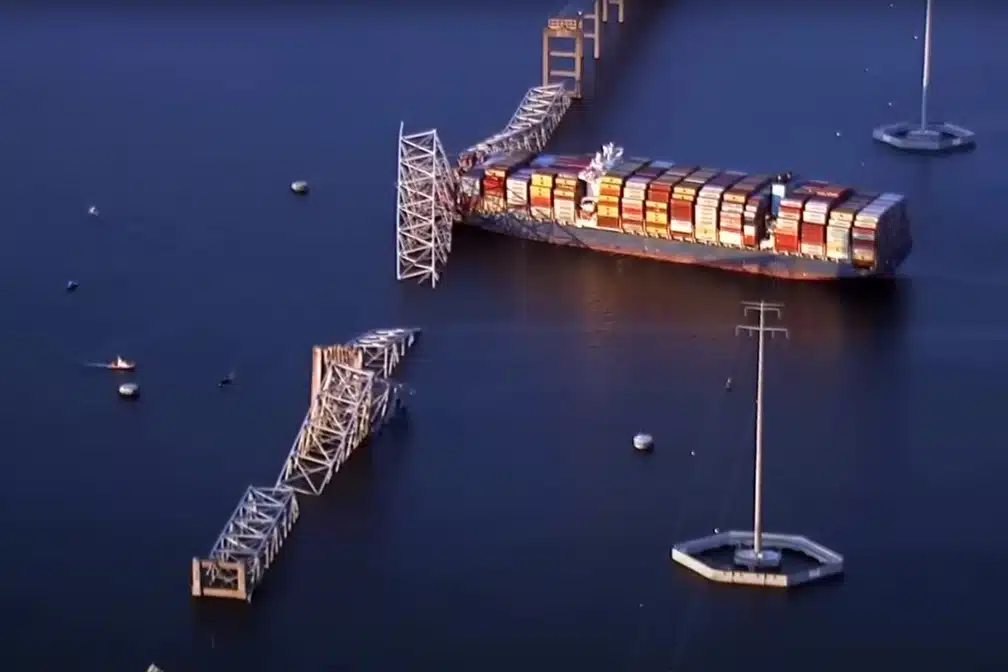April 2024 Truck and Warehouse Jobs shift, with trucking losing 300 jobs, and warehouses adding 7,600 jobs - highlighting industry volatility.
Continue Reading
May 19, 2024 7:46 pm

In the heart of Baltimore, a dramatic turn of events unfolded when the Francis Scott Key Bridge, a vital artery for the local and national transportation network, met its match against a container ship, leading to a collapse that’s thrown a wrench in the workings of trucking and shipping industries. As the dust settles and the water calms, a single tugboat pushing a fuel barge through an alternate channel tells a story of resilience and adaptation but also underscores the challenges lying ahead.
Late on the evening of April 1st, the tugboat embarked on its journey, carrying jet fuel to Dover Air Force Base in Delaware. This marked the first use of a makeshift channel designed to circumvent the bridge’s ruins—a beacon of hope for vessels trapped by the collapse. While this temporary path serves primarily those aiding the cleanup, it’s a crucial step in restoring some semblance of normalcy to the port’s operations. Yet, as officials scramble to open a second channel for larger vessels, the timeline remains uncertain, keeping many on edge.
The bridge’s sudden demise has sent shockwaves through the community, particularly hitting hard for truck drivers who’ve long relied on the bustling port to fill their cargo beds. U.S. Senator Ben Cardin and Maryland Governor Wes Moore, having met with some of these drivers, painted a vivid picture of the immediate economic toll and the looming uncertainty for small businesses—the backbone of the American economy. For truckers, the bridge was more than just a structure; it was a lifeline that, now severed, leaves them navigating a maze of delays and detours.
Near the heart of the turmoil, marina and restaurant owners, find themselves in uncharted waters. Their businesses, although busier with boats partaking in the recovery efforts and serving first responders at discounted rates, face an uncertain future. With pleasure boating likely to take a hit, local business owners eye the bridge’s eventual reconstruction as a double-edged sword that may bring new opportunities or challenges to local entrepreneurs.
In Annapolis, the air is thick with anticipation as lawmakers propose a bill to dip into the state’s “rainy day” fund, offering a financial umbrella to out-of-work port employees and small businesses teetering on the edge. This legislative effort aims not just to provide immediate relief but also to ensure the port’s swift recovery and the return of companies that have temporarily sought refuge in other harbors.
The task of clearing the bridge’s remnants is Herculean, with dive teams and workers painstakingly navigating the “chaotic wreckage.” The recovery of the lost construction workers remains a priority, a somber reminder of the human cost of such disasters. Meanwhile, the cargo ship Dali, the unintended catalyst for this calamity, sits motionless, its crew marooned, awaiting the next steps in a saga that’s far from over.
The collapse couldn’t have come at a worse time for the Port of Baltimore, a linchpin in the U.S. trade network known for handling more cars and farm equipment than any other national facility. With the port’s operations at a standstill, the timing disrupts the peak season for imports of farming machinery and construction equipment, triggering a ripple effect that stretches far beyond Baltimore’s waters.
In the aftermath, DAT Freight and Analytics reports a 57% surge in spot flatbed loads moved from Baltimore, a testament to the trucking industry’s scramble to adapt. The spike in loads to Chicago, by 117%, and the jump in spot flatbed rates, reflect the immediate repercussions on transportation costs and logistics strategies.
Despite the upheaval, the resilience of the trucking and shipping communities shines through. Legislative efforts, community support, and the ingenuity of local businesses paint a picture of a community coming together to navigate the challenges ahead.
As the industry looks towards recovery, the bridge collapse serves as a stark reminder of the fragility of our infrastructure and the profound impact such events can have on the national economy, the local community, and the individual lives of those who keep our country moving. In the shadow of the Francis Scott Key Bridge, a story of resilience, adaptation, and unity unfolds, charting the course for the road ahead.
April 2024 Truck and Warehouse Jobs shift, with trucking losing 300 jobs, and warehouses adding 7,600 jobs - highlighting industry volatility.
Continue ReadingBritish Columbia is taking a stand against commercial truck drivers who compromise the safety of the province's highways by hitting overpasses. This move is not just about
Continue ReadingAs we move through 2024, the trucking industry faces an unprecedented challenge with cargo theft reaching new heights. Experts forecast this year to mark a continuation of
Continue ReadingThe American Trucking Associations (ATA) has expressed strong opposition to the Department of Justice's proposed rule of marijuana reclassification.
Continue ReadingIn an effort to increase efficiency and sustainability in Trucking, Phillips Industries has launched their new, advanced, stick-on solar panels
Continue ReadingThe 2024 CVSA International Roadcheck is scheduled for May 14-16. Over 72 hours, inspectors across the US will conduct nearly
Continue ReadingAutomated License Plate Readers are a major advance in law enforcement technology but they raise significant privacy and oversight challenges.
Continue ReadingThe EPA's latest emission standards detailed in a final rule issued on March 29 are sparking vigorous debate within the
Continue ReadingOOIDA • ATA • DOT • NASTC • WOMEN IN TRUCKING • NPTC • DRIVER RESOURCES • TDN STAFF • ARCHIVES • SITEMAP